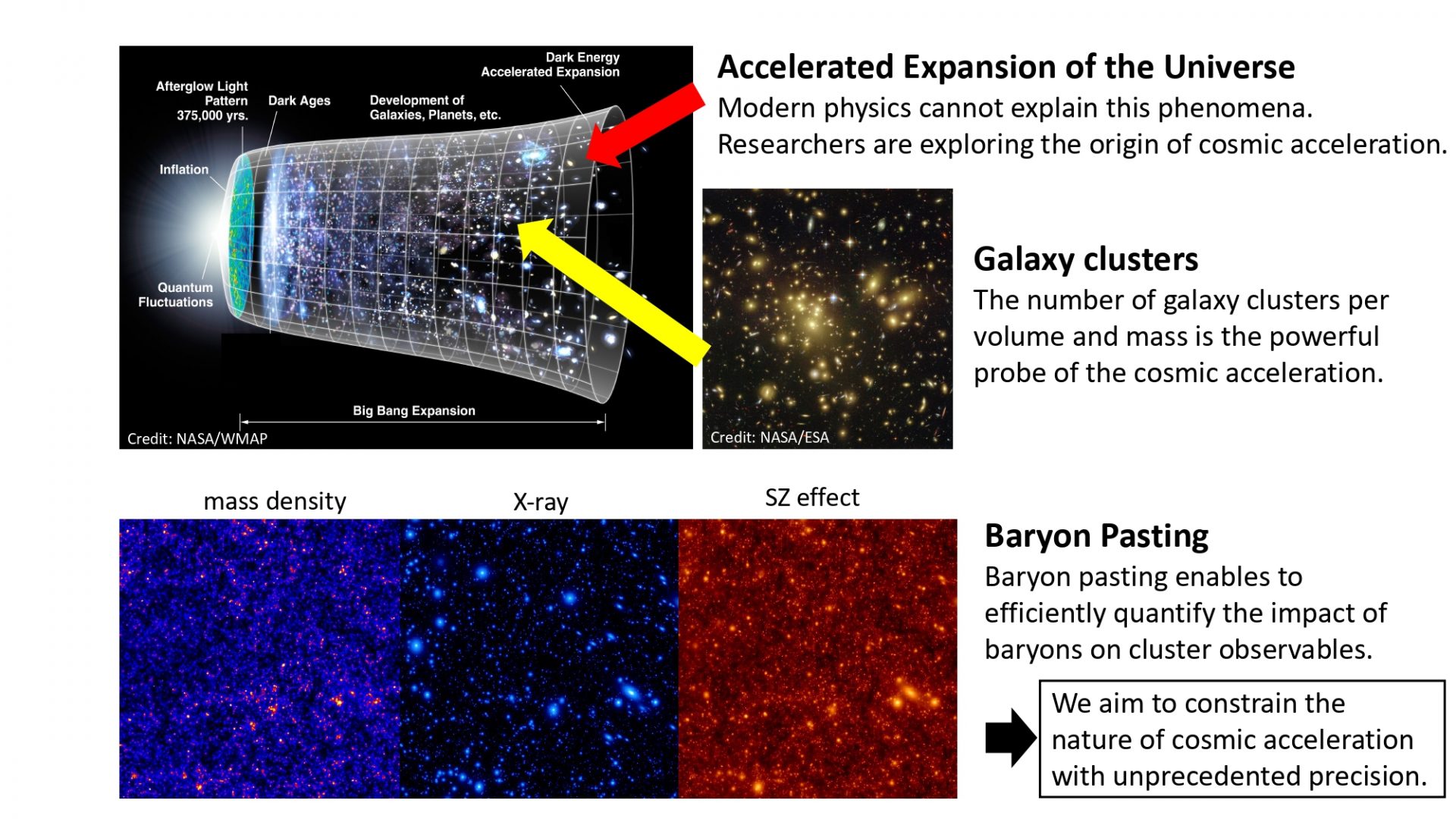observational cosmology

MIYATAKE Hironao
Starting year 2021
Nagoya University
Kobayashi-Maskawa Institute for the Origin of Particles and the Universe (KMI)
Associate Professor
Research Areas:Natural Science
Research fields
Research Interests
gravitational lensing
galaxy clusters
galaxies
survey astronomy
data science
Professional Memberships
Astronomical Society of Japan
Physical Society of Japan
American Astronomical Society
Main research topics
In the late 1990s, it was discovered that the expansion of the Universe is accelerating through observations of type-Ia supernovae. This phenomenon is counter-intuitive since celestial objects attract each other through gravity, which should result in decelerating expansion. The cosmic acceleration cannot be explained by fundamental theories of modern physics, such as particle physics and Einstein’s general relativity, and thus may indicate that the fundamental theories should be updated. Therefore, physicists and astronomers are exploring the origin of cosmic acceleration using big astronomical data sets obtained by cutting-edge telescopes.
I have been working on measuring the nature of cosmic acceleration through the large-scale structure of the Universe. The large-scale structure is the so-called “cosmic web” that consists of galaxies and galaxy clusters at the scales of billions of light-years. Since cosmic acceleration affects the large-scale structure, measurements of the large-scale structure enable us to investigate the nature of cosmic acceleration.
In my T-GEx program, I aim to constrain the nature of cosmic acceleration by measuring the number density of galaxy clusters per mass interval, the so-called halo mass function. The halo mass function is affected by cosmic acceleration. For example, the more rapidly the cosmic expansion is accelerated, the fewer numbers of galaxy clusters are formed. Here, it is of great importance to accurately measure the mass of galaxy clusters. Since most of the matter in the Universe is dark matter which does not emit light, observing astronomical objects which emit light, e.g., galaxies or the so-called “baryons,” does not provide an accurate measurement of cluster mass. Therefore, I have been using a phenomenon called weak gravitational lensing, which enables measuring the mass of dark matter and baryons.
To date, the theoretical models of halo mass function and weak lensing signal have been established through numerical simulations that consist of dark matter only. However, since statistical uncertainties are dramatically reduced due to the enormous amount of astronomical data sets, such theoretical models do not have enough accuracy in analyzing the data, and the effect of baryons should be included in these models. In my T-GEx program, I will constrain the nature of cosmic acceleration with unprecedented precision by quantifying the baryonic effects.

Representative papers
Miyatake H., Battaglia N., Hilton M., et al., “Weak-lensing Mass Calibration of ACTPol Sunyaev-Zel’dovich Clusters with the Hyper Suprime-Cam Survey,” ApJ, 2019, 875, 63
Miyatake H., Nishizawa A. J., Takada M., et al., “Subaru weak lensing measurement of a z = 0.81 cluster discovered by the Atacama Cosmology Telescope Survey,” MNRAS, 2013, 429, 3627
Research URL
Researchmap
https://researchmap.jp/hironaomiyatake
Hironao Miyatake’s Website
https://sites.google.com/view/hironaomiyatake/home
Laboratory Website
https://www.astro-th.phys.nagoya-u.ac.jp/c-lab/index.html
Global issues to be solved through this project
Precision cluster cosmology with next-generation large-scale galaxy surveys.
In this program, I will constrain the nature of cosmic acceleration through the measurement of halo mass function, using the big astronomical data set obtained by the galaxy imaging survey by Hyper Suprime-Cam (HSC), which is the newly developed wide-field prime focus camera at the Subaru Telescope. For this purpose, I will build accurate theoretical models for cosmological observables, such as the number density of galaxy clusters and cluster mass. I will collaborate with an international research group called “Baryon Pasters,” of which I am one of the founders, to build accurate theoretical models that incorporate baryonic effects. More specifically, I will quantify the relationship between the physical properties of galaxies clusters and cluster observables by applying machine learning techniques to hydrodynamical simulations. I also foster graduate students so that they can play a leading role in international research collaborations through this program.
Interview
No interview
News
-
お知らせ
An interview with T-GEx Fellow Dr. MIYATAKE Hironao, Nagoya University, has been published on the Kawaijuku website.
-
お知らせ
The paper of T-GEx Fellow Dr. MIYATAKE Hironao, Associate Professor, Nagoya University, has been published in 100 news articles overseas.
-
お知らせ
An interview by Kyodo News of T-GEx Fellow Dr. MIYATAKE Hironao, Nagoya University, was reported in several media outlets in Japan.
-
お知らせ
The research results of T-GEx Fellow Dr. MIYATAKE Hironao, Nagoya University, have been released in a press release.
-
お知らせ
The name was changed to T-GEx Fellow and T-GEx Associate.
-
お知らせ
Academic Mentor for FY2021 T-GEx Fellows has been decided.
-
お知らせ
Kick-off meeting for AY2021 T-GEx Fellows was held.
-
お知らせ
The 8 T-GEx Fellows were selected for AY2021 T-GEx program.

